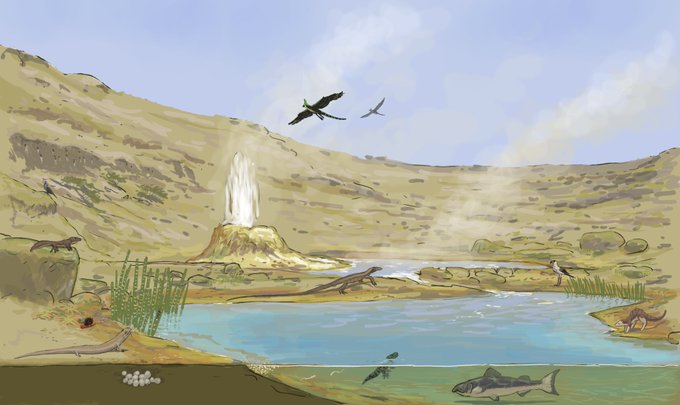PaleoceneのTwitterイラスト検索結果。 38 件
I WILL LIBERATE YOU FROM THE CHAINS OF YOUR LIFE
YOUR SOUL NOW BELONG TO MEEEEEEEE
RISE as a creature of darkness!
RISE as an undead machineeeeeee
IN THE NAME OF THE SORCERER POTATO-YI
VANQUISH THE PALEOCENEEEEE
YEEEEAAAAAAAHHHHHHHH https://t.co/Fmmf0qoQWQ
The most dominant groups of animals on Saikin are lineages from the Mesozoic with both dinosaurs and pterosaurs having been able to grow to massive sizes relatively easily
And their diversity has exploded since the paleocene
Day 8: Alcidedorbignya inopinata
This basal Pantodont lived in the Santa Lucia formation in Bolivia during the early Paleocene, shortly after the Chicxulub Impactor wiped out the majority of large reptiles across the planet.
#marchofthemammals2023 #paleoart #animalart
The front cover for PALEOCENE #4! The search for Sister continues, with a stunning realization. Join the mailing list to get early news about the crowdfunding campaign later this year: https://t.co/V1Q59Wvf5o #comics #ComicArt #paleoart #paleofiction #paleontology #Primates
Doing the ground sloth thing before there were ground sloths
Concept sketch of a pair of Barylambda, a large pantodont mammal from the Late Paleocene of North America
Here you can see what I did for Atlantis phase 1 and 2. 3 submission in total, my first 2 made it into the Paleocene island's fauna, now I'll cross fingers for my newest creation.
#Atlantisbestiaryphase2 #speculativebiology
And finally, here you have the antiq 04!
The Carbonemys was a giant tortoise that lived during the Paleocene in South America 🐢
Hope you like it ❤️🔥✍🏼
Results from the last Phase 1 #AtlantisBestiary stream!
We visited the rivers, lakes and caves of Atlantis during the Paleocene and worked on the compilation of all the images with a size chart.
#specevo #sciart #Atlantis #caves #river #lake #ecosystem #paleoart #paleocene
The volcanic habitat has entered, #AtlantisBestiary is a few species richer. Please appreciated the volcanic salmon. (also some smaller updates to the bushlands and uplands).
#specevo #Atlantis #paleocene #eocene #paleoart #volcanoes
We had a good first #AtlantisBestiary #paleostream
We explored the reef communities and the shoreline, we also took a look at the swamps but time ran out so we will continue this tomorrow after lunch!
#paleoart #sciart #paleocene #Atlantis #specevo #ecosystem
My entry to the #AtlantisBestiary , aquatic fauna of the Pavlopetri formation a lagerstätte which gives us an insight into the diversity of live in the coastal ecosystems of Late Paleocene Atlantis and which species called these ancient coasts home:
Pastel Paleotober Day 9: Waimanu 💝
Waimanu of New Zealand lived in the Paleocene soon after KPG Extinction. Taking advantage of the empty nieches left by the disappearance of most large marine predators, Waimanu took to the sea full-time as one of the first true penguins.
@tmkeesey @PaleoceneComic My illustration of a “hunter” stylized in vague homage to Paleocene issue 1.
Pastel Paleotober Day 5: Titanoboa 🐍
Titanoboa evolved in the tropical forests of Colombia at the end of the Paleocene. At 13 meters, Titanoboa was the largest snake ever. Despite often being depicted eating crocodiles, its teeth suggest that it mainly ate fish.
From the paleozoic to the paleocene~ #Mammoths galore! I did notice that all elephants today have eyes with black sclera and dark ember iris. I thought that maybe mammoths could have somethings similar.
#digitalart #pixelart #oc #kietafriends
#sizetwitter #gijinka #moemorphism
Pages 6–7 of PALEOCENE #3 are complete! More here for patrons: https://t.co/JieOQbA235
Titanoides
A large mammal with long claws and tusks, originally it was the largest known animal form the paleocene, it belongs to one of the earliest large mammal groups
ALT: its known from multiple skull and tooth, ironically for how bear like they are, they where herbivores
The script for PALEOCENE #3 is complete! https://t.co/aa4PJJeQHy












































